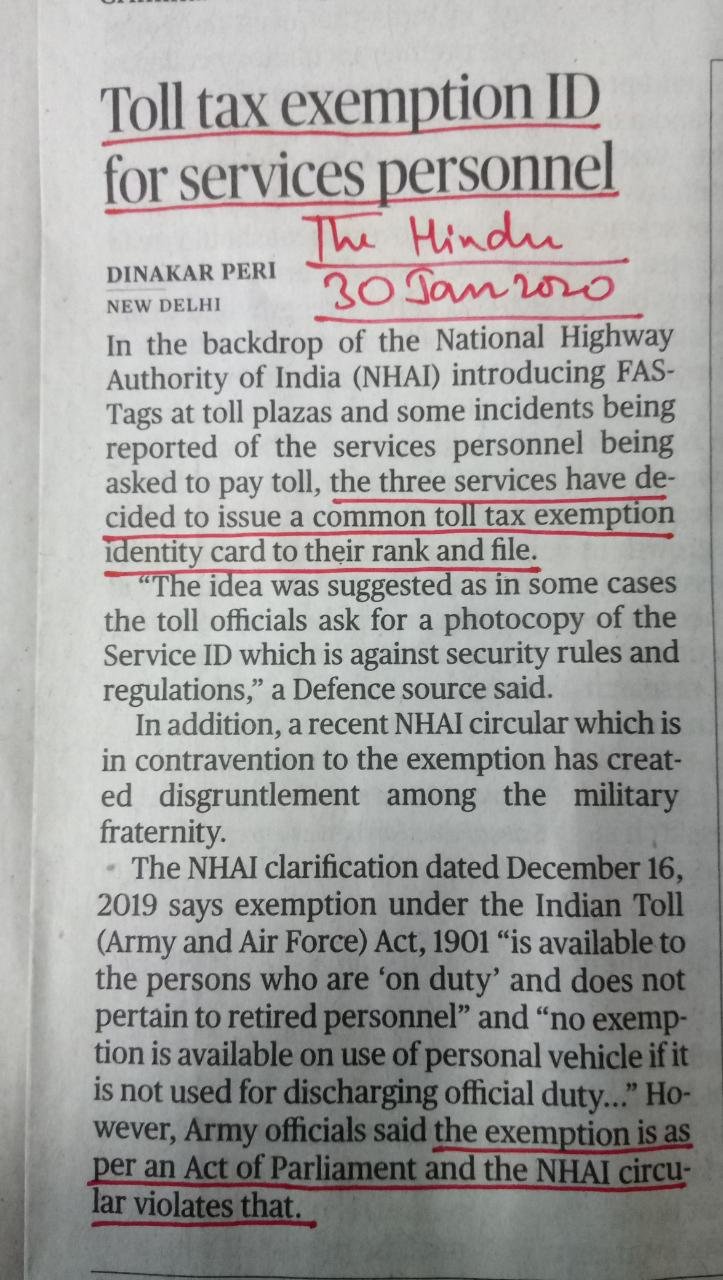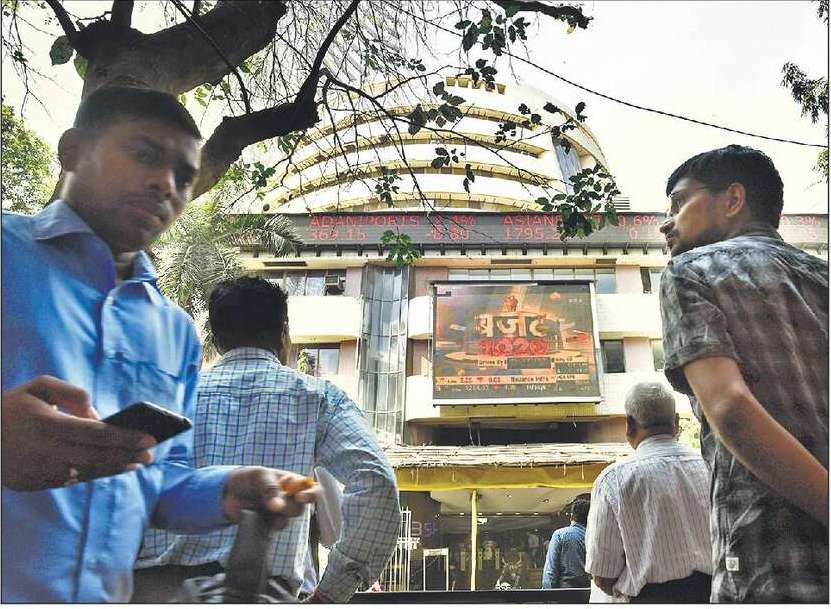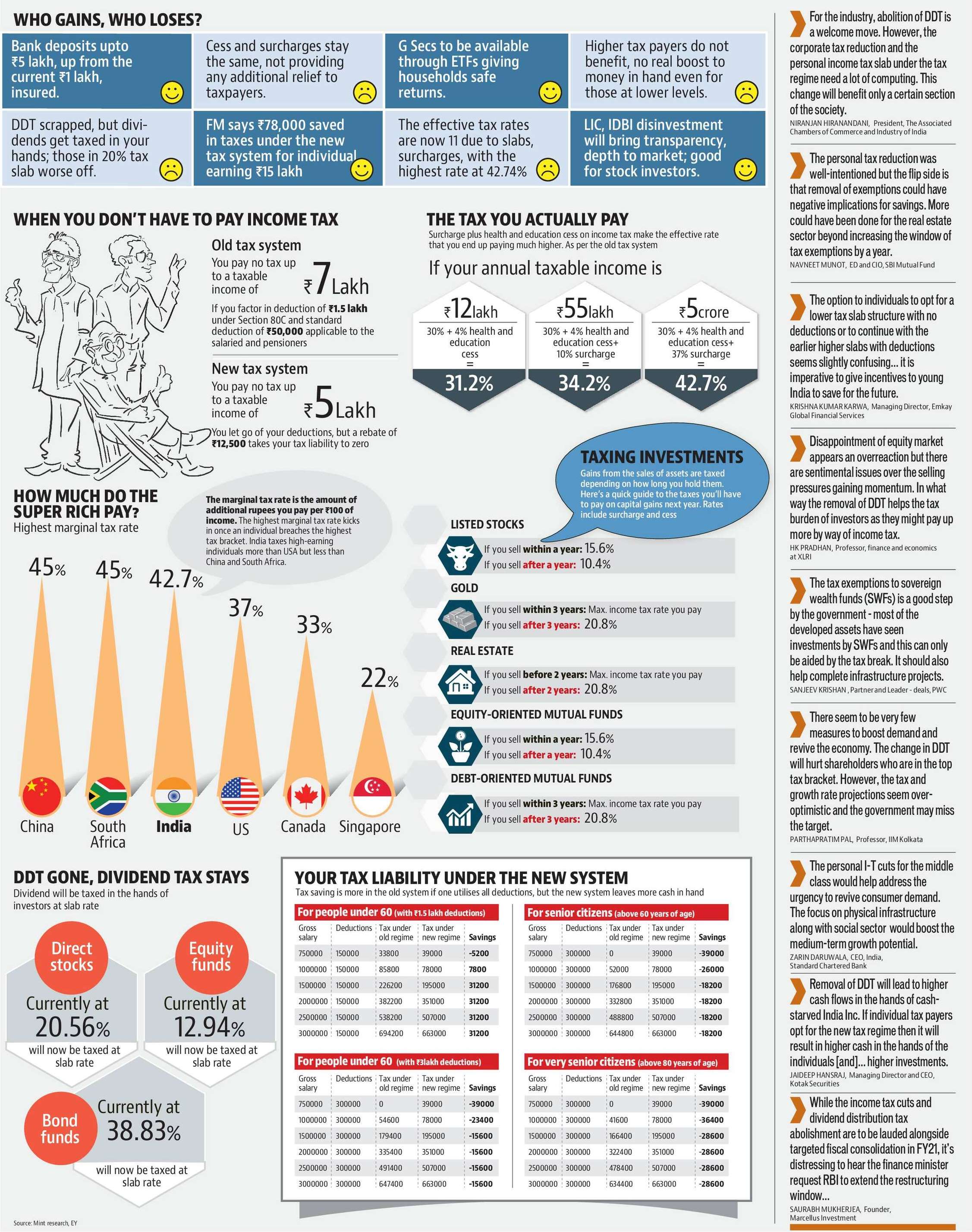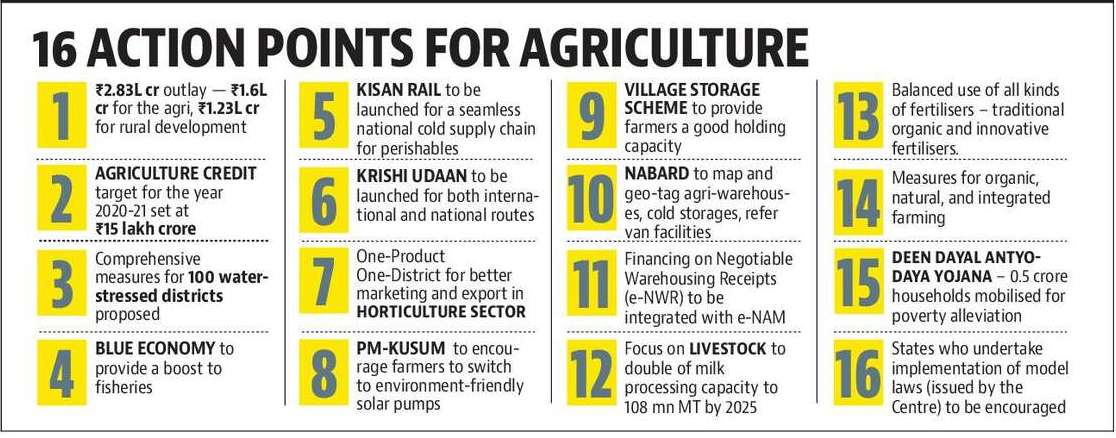Union finance minister Nirmala Sitharaman presented the government’s budget for the 2020-21 financial year on Saturday, signalling a focus on reviving growth with a new income tax scheme, a push for the rural economy, and some increased spending on crucial issues such as air pollution. Edited excerpts of her interview with HT’s R Sukumar, Mint’s Anil Padmanabhan and Doordarshan’s Ajay Mishra on Saturday.
Was this a tough budget to deliver looking at the current state of the economy?
The current state of the economy is showing signs of improving. Since July, we held discussions with various stakeholders and made announcements on a weekly and fortnightly basis. From July to December, there has been an effort on several aspects — on December 31, the infrastructure pipeline was announced. There have been continuous and detailed discussions of the finance ministry with industries and the concerned ministries. This budget addresses issues that were left over. We have been working continuously [since July] and if these efforts help the general public, we will be satisfied with the efforts.
One of the things that was expected from this budget was a stimulus to growth. If you had to pick two or three themes from the budget that you think will really give a stimulus to the economy, what would they be?
According to analysis by economists and policy experts, if private investment is not picking up, where does the buck stop? The buck stops at the government’s doors. The government will have to show that it is not waiting for private investments to happen – that will happen when it has to happen. But we have to go about investing. And that’s what we made very clear, saying ‘yes, we will invest and in infrastructure’.
I want to put out some things to strengthen this point. The Prime Minister announced this [plan] during his Independence Day speech that ₹100 lakh crore will be spent on infrastructure over five years. Soon after that, we had a task force and we looked into details. We consulted states and the private sector and came up with the pipeline of 6,500 projects. Within four months, we were able to come out with a complete pipeline of projects and, in this budget, we are helping that pipeline see the light of the day.
I have given enough concessions for sovereign funds that want to come into India but with the added condition that you invest in infrastructure. We have already given ₹22,000 crore for companies that will handhold and direct investments towards these pipeline projects. We are also investing in inland water connectivity projects… With all this, I want to say the [the government is meeting the] expectation that money should be spent in creating assets.
A focus visible in the budget is the rural economy and agriculture, where you have pledged to spend ₹2.83 lakh crore. In the 16-point action plan, how will you work with the states? And in the context of agriculture, how do you see it addressing problems in backward and forward linkage?
If you look at the 16 points as a continuum, you will see it has been created keeping backward and forward linkages in mind. And in it, the work that needs to be done in agriculture, and the work that needs to be done in agriculture-allied areas – all these areas involve a specific role for the youth. And to give them the requisite skills, skill development authorities have already held several discussions with multiple states. This is why I am saying that the planning for this budget did not start in the last three weeks – it began in July. So when it comes to youth, or allied industries – they follow a principled direction.
When you look at the rural economy, one of the things that seem to have helped this year was the job guarantee scheme MNREGA. You originally budgeted ₹60,000 crore but ended up spending close to ₹71,000 crore. This year, the budget estimates are lower than that. Are you expecting enough of a pick-up in rural jobs and rural economy to offset this or will you step in and invest more when a need arises?
The principle behind the MNREGA is that, when the need arises, we will give it. But if you notice in my budget speech, I have also mentioned the scheme will be extended for fodder creation. Because today, livestock in many of the water-distressed districts don’t even have fodder. Maintaining livestock is becoming an issue. If it is possible for us to use many of those not-so-fertile land – I wouldn’t say they are barren – to cultivate fodder, your local livestock will survive on it. And that itself can be one of the MNREGA activities. So we have tried to tie up some loose ends with the scheme.
One of the other things where there has been a reduction from last year’s budget estimates, is food subsidies. The fact that you also ended up spending less than what you budgeted last year suggests a capacity, utilisation or an implementation problem.
It can also be seasonal. Sometimes when people are migrating, and the interoperability that we are bringing in, it can be due to that. I don’t think I will be able to put my finger on what specifically caused it. But it is not a conscious reduction from our side.
On direct taxation, what compelled you to create the new slabs for Income Tax? And now for individual tax payers, what will be a better option, in your opinion?
The idea behind this move was to make tax filing easier and simpler for the people. They should be able to understand what the tax burden on them is exactly. The myriad of exemptions – 120 exemptions that have piled up over the decades – also creates a problem of revenue estimation for the tax department. Moreover, as a taxpayer, a person needs to turn to a professional to understand what exemptions they should use. Our belief was that ultimately, tax should be simpler and the burden lighter. This is why, I can say that from now, we are beginning on a path to reduce exemptions while also lowering the rate. The total saving because of reduced tax will be high in the new scheme. I have also asked the revenue secretary to issue a clarification note today itself that even in the new scheme, four new exemptions have been added because we do not want to tax the savings people already have. Justifiable, simple, straight-forward exemptions have been added to the new system.
So the idea is over a period of time, all exemptions will go?
Yes, we want to remove gradually everything called exemptions. I am not waiting for a golden day to do it, but have started the process by offering a new stream. I am not forcing people – you can continue to be where you want to claim exemptions. But gradually, when exemptions go, I will also give an attractive rate.
Do you think the tax changes that you made will be significant enough to impact consumption?
Yes, I am giving you an example. A person with a salary of ₹15 lakh per annum will save ₹78,000 and he will have to use that money – either in savings or in consumption.
So what about the fear that some people have that savings are gone altogether?
I don’t want to believe that a taxpayer will have to be goaded to save. A taxpayer is smart enough, intelligent enough, responsible enough to take a call on how much he wants to spend or save. We should trust him to that extent.
On the tax issue, the new charter appears to be the first time a government has gone out and said that taxpayers have the right to not be harassed. Can you tell us a little bit about this?
I have gone around the country talking to tax administrators and said that, ‘yes you have a target to collect revenue but please don’t overreach – we have been assuring taxpayers’. All that is on one level, but the Prime Minister himself has wondered if we really respect the taxpayer. Hence, we thought if we are clear about the intention, why should we not put into law? If my research is right, there are only three countries that have it in their law itself – Australia, USA and Canada. I am glad we have joined that league to assure taxpayers that this government’s intention is to trust wealth creators and taxpayers.
You took a leeway of 0.5 percentage point to raise the fiscal deficit target from 3.3% to 3.8%, and you say you will, moving forward, return to a path of fiscal discipline. What does the budget say to domestic and international investors?
You are referring to the FRBM act – and since circumstances now needs us to increase spending, this has been a deliberate decision. We have also had issues with revenue generation, since GST collections had not been up to the target for a few months this year. Given both of these circumstances, we have utilised the forbearance clause [in the FRBM act]. Otherwise, we would not have been reflecting the truth.
If you look at all the numbers, there is a level of pragmatism. Some of the tax receipts you are estimating this year are lower than last year. You think they are achievable?
Yes, [benefits from] corporate tax cut will have show after a time lag. But I have to bear the brunt in showing that I lost the money [in revenue] today. If I am able to come back to some discipline in fiscal deficit by saying 3.5% in the budget estimate, it is because I expect revenue generation to improve.
The nominal growth expectation of 10% is the lowest in a long time.
It is realistic, I think. Because we don’t want to give an [another] impression. In fact in the House when I said this, some members misunderstood so I had to repeat that it is nominal GDP growth.
How will you define this budget, as a matter of a central theme?
On social media, the ministry ran a hashtag – JanJanKaBudget. That was the objective, to touch every section. And also to send the larger message that this is a responsible government, it knows its limitations and its responsibilities. It is also a government that knows that only half of India’s potential is being utilised. We will do whatever it takes to encourage the utilisation of the country’s full potential.
One very big strand of your budget has been this emphasis on market forces. To give you an example: normally where FMs would have used the fiscal space to spend more, you have chosen the option of cutting taxes and giving power to individuals and companies on how they spend. Is this a seminal shift in the ideological approach to budget making?
It is a shift to suit, and in line with, our ideology. The government has to do only as much as is expected from a government. The PM made this clear when he said—government should have an impact but not make you feel indebted, the government’s role cannot be overwhelming. If I have to constantly spend, collect, it is never going to end. You will never be able to work out a mechanism through which the economy can drive itself at a pace at which it can move, not generate too much heat and at the same time be sustainable in the way in which it moves forward. Most of the things where we are putting our equity, we are also saying it should be in Public Private Partnership (PPP) mode. We are also saying that states will also have to be in it. This whole idea of only the central or state government (will spend) no longer works. It has to be all three together. Where I have land, I give you land. Where I have power generation capabilities, I give that but where others will have to come in, they will.
Similarly in railways, some of the prime routes are suffering because net collection has not been improved nor is cross-subsidy any longer justifiable. You can’t leave the poor (paying) high rates. Some of these routes will be given out in PPP model. Bengaluru suburban is using railway tracks around the city; the decision between the state and us is that it should be on metro pricing model. It can’t be railway subsidising tickets and the (state) government running it. That is just not sustainable. In everything that we have announced, the directional change in which that project will have to run for itself (is made clear); eventually (it will have to) be sustainable on its own, is the plan.
Even in infrastructure, this sovereign wealth fund, instead of the classic model of the government going out and investing money you have created the space for them to come in and made it very attractive for them…
We have given them enough incentive. We have made sure that the money they earn over interest and other things will not be taxed, provided they spend on infrastructure, provided they lock in for a certain number of years. It is not like it’s just been given. Every single word uttered in the budget has gone through different layers and all of us will own it up. The time that the PM has given to see that they are falling in place is amazing.
The other thing that we have noticed in the last five years is that the public sector is no longer what your political opponents call ‘family silver’. In this budget, you have taken it to a different level. You are trebling your disinvestment receipts. Are we seeing another big shift?
Yes. If you have noticed, I have said that money from disinvestment will go to the companies which are going to be investing in long-term infrastructure. Sale of ‘family silver’ is not going for revenue expenses, it is going towards greater asset creation, responsible disinvestment, responsible sale, if at all, of family silver. That is again being put towards asset creation. That asset which you no longer can run efficiently and make profit is clearly offloaded, but here we put (the receipts) into the infrastructure pipeline. The two companies which I’ve mentioned will receive the funds. They will take the money. It is a responsible way in which public expenditure is being handled.
So you are saying it won’t be used to balance the fiscal deficit or to finance it?
No, I have very clearly told you that this is how it is going. Is that a general off-the-cuff remark? No. We have already given ₹22,000 crore towards pipeline projects to these two companies, which means we are putting the money where our mouth is.
But is this number achievable?
Absolutely, I think because to be fair, the last announcement was made in July. Again to be fair, the officials have done tremendous footwork to get it all off the table.
LIC will be the key, I guess to meet the disinvestment target..
The leg work was done between July and now. Because all this has its own timelines, I am not benefiting by the same this financial year, but it’s going to the next (fiscal). But ruthlessly to think you did not do it within a financial year and will you be able to do it next time is not right because this time we have done the footwork and it’s going to be ready immediately after the commencement of the next year.
And what is the idea behind getting LIC to do an IPO?
(To get) More money to be invested by retail investors, more money to come in from others. Why should it be only the government investing? More public, more opening up. The crowding out does not happen; crowding in should come in now.
You are projecting an increase in your income tax collections despite the cut that you are pushing through right now; so, do you think it is achievable?
I am keeping both the systems going, right?
Or you are expecting some buoyancy?
Of course. Because income tax I don’t think is suffering now. The direct tax collection is going on fine. The GST got affected and it is now restored.
In fact, there is a significant increase in GST, even in these things… you are expecting a recalibration of rates? You are counting on that?
Yes, that will also be a part. But there is a lot of removing the deadwood, the evasion which is happening is being plucked. Otherwise, technically, as per media assessment, nothing has changed in the overall.
Going back to your statement of involving states as a stakeholder. Are we also seeing this budget signal the limits of a Union government shouldering the economic burden as it were, and is now looking to involve states?
No, no I wouldn’t see it like that. Why should we involve the states more? (Because) Most of the activity happens there. The land is with them, zones are with them. If we want every district to be an export hub, the activities start from them. The economic survey has one very interesting data if you noticed. The Chief economic advisor has based it on hard data and he has taken on board nearly 480-odd districts in doing that data. Because of private entrepreneurship, the growth is unbelievable at the district level. So, why would it not have an optimism about revenue generation?
The stock market seems to have reacted adversely to the budget. As an FM, does it concern you?
It is not a fully open stock market today (Saturday). Not all wings of the stock market have been operational today. We will have to wait for Monday.
So it doesn’t worry you as an FM?



























































































































